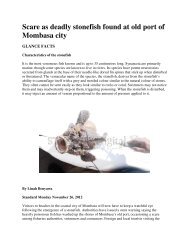Kenyan coral reef-associated gastropod assemblages: distribution and
Kenyan coral reef-associated gastropod assemblages: distribution and
Kenyan coral reef-associated gastropod assemblages: distribution and
You also want an ePaper? Increase the reach of your titles
YUMPU automatically turns print PDFs into web optimized ePapers that Google loves.
Coral Reefs (1990) 9: 63-74<br />
<strong>Kenyan</strong> <strong>coral</strong> <strong>reef</strong>-<strong>associated</strong> <strong>gastropod</strong> <strong>assemblages</strong>:<br />
<strong>distribution</strong> <strong>and</strong> diversity patterns<br />
T.R. McClanahan *<br />
Coral Reef Conservation Project, P.O. Box 99470, Mombasa, Kenya<br />
Accepted 6 November 1989<br />
Abstract. A survey of Kenya's shallow water (
64<br />
2~<br />
3~<br />
4~<br />
KENYA<br />
40eE 41~<br />
' ",RSOMALIA<br />
z > ~C~rnd '<br />
-~ ~o R~ ~;':" ....<br />
....... Z:::'::<br />
~ a s T e n e ~ -wi ' "<br />
iU~g,~a/a:..-.<br />
\r~rRas'Ngomeni - -.<br />
P ~:!.-:.P !i'..!-:. '.'..-. ::..<br />
Ma'~ndie~PM:aiindi North Reef<br />
~r Fringing Reef F<br />
.<br />
~i: Wa)camu "" ' ' . O C E A N<br />
~,6.vipingo .'. ' .<br />
~.::~;dKanama i. . . .<br />
Bambud:". . . "<br />
ombasa", i<br />
~rShelly : ".' ' ,. 9<br />
):!:,.>-: 9 .<br />
Diani : ',: - ' , "<br />
unguti , , '<br />
Fig. 1. <strong>Kenyan</strong> coastline <strong>and</strong> study site locations<br />
NDIAN<br />
o Study Sites<br />
0 20 40 610<br />
the southern terminus of this <strong>reef</strong>. South of Diani <strong>coral</strong> rock isl<strong>and</strong>s,<br />
including the Kisite-Mpunguti MNP, typify the <strong>reef</strong> geomorphol-<br />
ogy also typical of northern Tanzania's coastline. North of Malindi,<br />
the Sabaki <strong>and</strong> Tana rivers discharge into the Indian Ocean <strong>and</strong><br />
<strong>coral</strong> <strong>reef</strong>s are patchily distributed up to the Somali border around<br />
<strong>coral</strong> rock isl<strong>and</strong>s.<br />
Thirteen sites along the <strong>Kenyan</strong> coast were chosen for surveying<br />
(Fig. 1) including four protected parks (Malindi, Watamu, Bamburi<br />
<strong>and</strong> Kisite) <strong>and</strong> the Mpunguti Reserve. The Bamburi MNP was sur-<br />
veyed before it was established as a Park <strong>and</strong> therefore not consid-<br />
Table 1. Reef flat heights in relation to datum (m) <strong>and</strong> total densities (:~/h, x_SEM)<br />
(n = number of samples) of the <strong>gastropod</strong> fauna at the studied locations. Portions of this<br />
data are from McClanahan (1989). Correlation between <strong>reef</strong> height <strong>and</strong> density not<br />
significant<br />
Location Heigth Reef edge Reef flat Reef lagoon<br />
m<br />
Kisite<br />
Mpunguti<br />
Dianl<br />
Shelly<br />
Bamhuri<br />
Kanamai<br />
Vipingo<br />
Watamu<br />
Malinidi<br />
North Reef<br />
Malindi<br />
Fringing<br />
Reef<br />
Ras Tenewi<br />
Zinyika<br />
Pate<br />
Total<br />
1.37 122.0_+17.8 (6) 108.8+10.3 (4) 12.3_+ 1.5 (8)<br />
1.20 64.0+ 8.9 (4) 174.5+ 5.3 (4) 17.6+ 7.6 (8)<br />
0.80 27.9-+ 3.7 (3) 84.34-14.3 (4) 68.3+ 3.0 (7)<br />
1.40 102.3_+36.0 (3) 113.0_+33.6 (3) 93.34-12.8 (3)<br />
1.05 45.7_+ 6.7 (3) 68.0_+13.9 (4) 21.0_+ 7.4 (6)<br />
1.40 93.0_+ 7.6 (3) 127.0___22.9 (3) 47.8-+ 6.7 (8)<br />
1.45 114.0___10.6 (3) 59.04- 6.4 (3) 81.3_+52.4 (3)<br />
- - - 14.0-+ 4.4 (5)<br />
0.80 33.7_+ 5.5 (3) 62.44-13.6 (3) 15.2_+ 2.3 (6)<br />
1.50 52.3_+13.3 (4) 91.74-28.3 (3) -<br />
- 24 (1) 10.2+ 4.1 (6)<br />
- - 29.5+23.5 (2)<br />
- 24.3+ 5.6 (6) 14.7+ 3. (3)<br />
72.8+11.9 (32) 91.3+13. (38) 35.4+ 8.6 (65)<br />
ered protected in the data analysis. All other Parks <strong>and</strong> Reserves<br />
have existed for over 15 years. Parks exclude fishing <strong>and</strong> shell col-<br />
lecting <strong>and</strong> reserves exclude shell collection <strong>and</strong> some fishing<br />
methods.<br />
Sampling was undertaken by a r<strong>and</strong>om walk or swim procedure<br />
(Kohn 1968; McClanahan 1989) which allows greater time ef-<br />
ficiency within the intertidal zone; Kenya has a 4 m tidal range<br />
(Brakel 1982). McClanahan (1989) details the sampling procedure.<br />
Briefly, all sampling was undertaken within shallow (< 2 m) <strong>reef</strong> lo-<br />
cations (<strong>reef</strong> edges, <strong>reef</strong> fiat <strong>and</strong> <strong>reef</strong> lagoons) during daylight spring<br />
low tides using a one hour sample. When a species was first encoun-<br />
tered the time was recorded <strong>and</strong> subsequently encountered individ-<br />
uals of the species tallied. Sites were visited at different times <strong>and</strong><br />
sampling included broad surveys to include the largest area possible.<br />
During samples small <strong>coral</strong> boulders were overturned but only as<br />
frequently as they were encountered. Continuous movement during<br />
sampling may have caused some smaller <strong>and</strong> cryptic species to be<br />
missed or under-sampled, but McClanahan (1989) found no signif-<br />
icant difference between 2 independent observers using this method.<br />
Most <strong>reef</strong> locations were sampled a minimum of three times (i.e. 3 h)<br />
but this depended on the <strong>reef</strong>'s size. Sample sizes are given in<br />
Table 1. Sampling was undertaken at various times between<br />
November 1986 <strong>and</strong> July 1988. A 1 h sample is estimated to cover<br />
approximately 1000 m z (McClanahan 1989).<br />
Spry (1968) is the most complete reference for East African gas-<br />
tropods but some nomenclature has changed since this publication.<br />
Therefore, the works of Dance (1974), Oliver (1975), Richards<br />
(1984) <strong>and</strong> Abbott <strong>and</strong> Dance (1986) were also consulted. Only live<br />
prosobranch <strong>gastropod</strong>s were identified <strong>and</strong> included within this<br />
study.<br />
Kenya's fringing <strong>reef</strong> consists of three locations; <strong>reef</strong> edges, flats<br />
<strong>and</strong> lagoons. Reef edges exist between MLWN <strong>and</strong> MLWS <strong>and</strong> are<br />
directly exposed to waves. Reef flats are shallow <strong>reef</strong> tops <strong>and</strong> ex-<br />
posed to air during most low tides. Reef lagoons are the shallow pro-<br />
tected areas l<strong>and</strong>ward of the <strong>reef</strong> flat. Kenya's <strong>reef</strong> lagoons are often<br />
composed of extensive seagrass beds but during sampling these<br />
areas were generally avoided in favor of hard substrate <strong>and</strong> <strong>coral</strong><br />
outcrop areas. No back-<strong>reef</strong> rock platforms or rocky shores were<br />
sampled. Some <strong>reef</strong>s lacked one or more of the three <strong>reef</strong> locations<br />
<strong>and</strong> some sites such as the rock isl<strong>and</strong>s of Kisite, Mpunguti wa Juu,<br />
Ras Tenewi, Zinyika <strong>and</strong> Pate lacked true <strong>reef</strong> lagoons but the<br />
deeper leeward sides of these sites were included as lagoons in the<br />
data analysis. The Pate site included samples from three adjacent
eefs known locally as Pezali, Mwendo wa Pate <strong>and</strong> Kitwayu Upuu.<br />
Reef flat heights were estimated by observing the time that water<br />
crossed the <strong>reef</strong> <strong>and</strong> calculating the height in relation to datum<br />
(Kenya Tide Table 1987).<br />
Data allowed the calculation of diversity, relative density, <strong>and</strong><br />
species richness. Diversity (D) was calculated using a modification<br />
of Simpson's (1949) equation where:<br />
n<br />
D = 1 - Z N- (1)<br />
i=1<br />
Pl is the number of individuals of species i divided by the total<br />
number of individuals in the sample. D varies between 0 <strong>and</strong> 1, 0 the<br />
lowest <strong>and</strong> 1 the highest possible diversity. Species richness was<br />
principally estimated by species-time relationships fitted to the<br />
equation:<br />
S = Ct z, (2)<br />
where S is the number of species found at time t; C <strong>and</strong> the exponent<br />
z are constants determining the shape of the curve. Species-individ-<br />
ual curves were also generated for comparisons of <strong>reef</strong> locations.<br />
Comparisons of species composition were made between sites<br />
using similarity indices <strong>and</strong> cluster analysis. Sorensen's (1948) index<br />
was principally used to calculate similarity (S) by the equation:<br />
S = 2C/A + B, (3)<br />
where A <strong>and</strong> B are the number of species in each of the two sampling<br />
location <strong>and</strong> C is the number of species in common. The ten most<br />
common species within each site were used for this comparison. The<br />
Sorensen index considers only the presence or absence of a species<br />
<strong>and</strong> therefore the Bray-Curtis measure of similarity (Bray <strong>and</strong> Cur-<br />
tis 1957) was also used to compare selected southern <strong>Kenyan</strong> <strong>reef</strong>s.<br />
All cluster analysis used average between-group linkages.<br />
Comparisons between protected <strong>and</strong> unprotected <strong>reef</strong>s were<br />
made between community structure variables <strong>and</strong> population densi-<br />
ties of commonly collected shells. Gastropod population density<br />
variables were regressed against sea urchin <strong>and</strong> fish population den-<br />
sity data within six southern <strong>Kenyan</strong> <strong>reef</strong> lagoons (Diani, Bamburi,<br />
Kanamai, Vipingo, Watamu <strong>and</strong> Malindi's North Reef) collected<br />
by McClanahan <strong>and</strong> Shafir (in press), McClanahan <strong>and</strong> Muthiga<br />
(1989) <strong>and</strong> this study. Fish surveys consisted of transects (n= 3 to<br />
6 per site; 5 m x 100 m) in which total observable fish <strong>and</strong> species<br />
from potential invertebrate predator families (Labridae, Diodonti-<br />
dae, Lagocephalidae <strong>and</strong> Balistidae) were counted. Movements<br />
were slow (20 to 30 min per transect) <strong>and</strong> visibility was never less<br />
than 8 m during surveys. Sea urchins were counted in 10 or 25 m 2<br />
areas (n= 9 to 27 per site) at r<strong>and</strong>om locations within <strong>reef</strong><br />
lagoons.<br />
Results<br />
The <strong>gastropod</strong> assemblage is characterized by low popu-<br />
lation density, high diversity <strong>and</strong> high variability in spe-<br />
cies composition. Densities were highest on <strong>reef</strong> flats <strong>and</strong><br />
edges <strong>and</strong> lowest in <strong>reef</strong> lagoons (Table 1). Southern<br />
<strong>Kenyan</strong> <strong>reef</strong>s appeared to have similar between site den-<br />
sities, but the northern rock isl<strong>and</strong>s of Ras Tenewi <strong>and</strong><br />
Pate were characterized by low densities within both <strong>reef</strong><br />
flats <strong>and</strong> lagoons. Regressing <strong>gastropod</strong> density <strong>and</strong> <strong>reef</strong><br />
height produces a positive (r= 0.38) but insignificant re-<br />
lationship. Overall diversity was high <strong>and</strong> there were no<br />
clear distinctions in diversity among <strong>reef</strong> locations<br />
(Table 2). There was notably lower diversity in some of<br />
the southern unprotected <strong>reef</strong> lagoons such as Diani,<br />
Shelly <strong>and</strong> Vipingo. This is attributable to the relatively<br />
high densities of a few species within these locations<br />
Table 2. Diversity of the <strong>gastropod</strong> fauna at the studied locations,<br />
sites <strong>and</strong> totals (x_+SEM). Kruskal-Wallis test of totals not<br />
significant. Portions of these data are from McClanahan (1989)<br />
Location Reef Reef Reef<br />
edge flat lagoon<br />
Kisite 0.87 0.79 0.88<br />
Mpunguti 0.78 0.88 0.89<br />
Diani 0.90 0.84 0.44<br />
Shelly 0.86 0.86 0.59<br />
Bamburi 0.77 0.89 0.92<br />
Kanamai 0.66 0.75 0.85<br />
Vipingo 0.79 0.89 0.51<br />
Watamu - - 0.85<br />
Malindi 0.90 0.92 0.91<br />
North Reef<br />
Malindi 0.83 0.90<br />
Fringing Reef<br />
Ras Tenewi - 0.76 0.81<br />
Zinyika - - 0.84<br />
Pate - 0.88 0.81<br />
Total 0.82_+0.03 0.86_+0.02 0.78-+0.05<br />
(Table 3). For instance, Diani had high densities of the<br />
<strong>coral</strong>livore Coralliophila violacea, Shelly the herbivore<br />
Cypraea annulus <strong>and</strong> Vipingo the detritivore/herbivore<br />
Strombus gibberulus. High densities of Cerithium alveolus<br />
were also observed within Kanamai's <strong>reef</strong> lagoon, al-<br />
though not during sampling.<br />
Species composition comparisons between <strong>reef</strong> loca-<br />
tions indicates high variability (Table 3; Figs.2, 3).<br />
Cluster analysis of the southern <strong>reef</strong>s (Fig. 2) indicates<br />
species composition differences based on <strong>reef</strong> locations.<br />
Reef lagoons clustered into one group with the exception<br />
of the shallow (ca. 0.3 m deep) Kanamai <strong>reef</strong> lagoon.<br />
There was greater species composition similarity between<br />
<strong>reef</strong> flats <strong>and</strong> edges. These patterns were consistent re-<br />
gardless of the similarity index. Average species similarity<br />
(Sorensen's index) for the common (top ten) species was<br />
0.34+0.18 (x+SD) for <strong>reef</strong> lagoons, 0.43+0.13 for <strong>reef</strong><br />
flats <strong>and</strong> 0.32 -t- 0.11 for <strong>reef</strong> edges. Reef flats appeared to<br />
have slightly higher similarities due to the ubiquity of<br />
some species such Morula granulata, M. marginatra, Cy-<br />
praea annulus <strong>and</strong> Vasum turbinellus (Table 3). Cluster<br />
analysis of within site comparisons for the entire <strong>Kenyan</strong><br />
coastline failed to show distinct regional associations or<br />
distinctions based on management practices with the ex-<br />
ception of <strong>reef</strong> lagoons (Fig. 3). Protected <strong>reef</strong> lagoons<br />
clustered into a group which included Bamburi, Diani<br />
<strong>and</strong> Ras Tenewi. Kenya's northern <strong>reef</strong>s, Zinyika <strong>and</strong><br />
Pate, appeared to share few species with other <strong>reef</strong>s.<br />
Species richness data (Table 4) <strong>and</strong> the species list<br />
(Appendix) indicate a high faunal diversity. A total of<br />
135 species from 25 families were recorded. Data fit well<br />
to species-time curves, r values were above 0.95 but aver-<br />
aged 0.989 + 0.012 (_+ SD). Overall, z values were high for<br />
an assemblage; being higher within sites (Table 4) than<br />
for combined sites (Fig. 4). Species-time <strong>and</strong> species-indi-<br />
vidual curves (Fig. 4) indicate that species richness within<br />
<strong>reef</strong> locations did not reach an asymptote. R<strong>and</strong>omly<br />
combining sites <strong>and</strong> locations for a <strong>Kenyan</strong> total (Fig. 5)<br />
indicates that species richness approached an asymptote.<br />
65
Table 3. The ten most common species <strong>and</strong> their densities (#/h, x SEM) within studied locations<br />
Location Reef edges Reef flats Reef lagoons<br />
Cypraea annulus 31.3 5.3<br />
Vasum turbinellus 14.5 4.6<br />
Thais tuberosa 12.8-t- 3.4<br />
Cypraea lynx 10.3 2.2<br />
Kisite Conusfulgetrum 5.8 1.5<br />
Conus rattus 4.7 1.4<br />
Vasum rhinoceros 2.5 1.1<br />
Strombus gibberulus 2.5 0.9<br />
Drupa morum 2.3_+ 2.0<br />
Conus miles 2.2 0.5<br />
Vasum turbinellus 28.0 3.2<br />
Vasum rhinoceros 5.3 0.5<br />
Morula granulata 4.0 1.3<br />
Conus ebraeus 3.5 1.9<br />
Mpunguti Thais tuberosa 3.3 0.8<br />
Drupa morum 2.8 1.8<br />
Conusflavidus 2.3 1.0<br />
Thais savignyi 2.3 1.4<br />
Conusfulgetrum 1.5 0.3<br />
Mitra chrysalis 1.5 0.6<br />
Latirolagena smaragdula 5.3 2.6<br />
Conus lividus 4.8 0.8<br />
Conusfulgetrum 3.5 1.0<br />
Thais tuberosa 3.3 0.8<br />
Diani Conus rattus 2.3_+ 0.8<br />
Cypraea moneta 1.1 1.1<br />
Cypraea annulus 0.8_ 0.8<br />
Conus miles 0.8 0.5<br />
Turbo brunneus 0.8 0.5<br />
Morula spinosa 0.6 0.3<br />
Morula granulata 27.0 19.0<br />
Drupa morum 23.7 7.9<br />
Cypraea annulus 9.0 5.9<br />
Vasum turbinellus 5.7 4.3<br />
Shelly Thais savignyi 5.7 4.3<br />
Morula marginatra 5.0 3.6<br />
Thais tuberosa 3.3 0.9<br />
Morula spinosa 2.3 1.2<br />
Trochus erythraeus 2.0__ 0.6<br />
Drupa morum 19.7 6.5<br />
Conus flavidus 4.7 2.3<br />
Thais tuberosa 4.7 0.7<br />
Latirolagena smaragdula 3.7 2.7<br />
Bamburi Conus rattus 3.0 0.0<br />
Bursa bufonia 2.3 2.1<br />
Conus lividus 2.3 1.5<br />
Trochus tentorium 1.0 0.6<br />
Bursa rosa 0.7 0.6<br />
Conus miles 0.7 0.6<br />
Drupa morum 50.7_+ 6.2<br />
Thais tuberosa 14.0 1.2<br />
Morula granulata 12.0_+ 2.5<br />
Morula marginatra 4.3 ~.5<br />
Kanamai Drupa albolabris 3.3 0.3<br />
Drupa ricinus 2.0 1.0<br />
Conus rattus 1.3 0.3<br />
Latirolagena smaragdula 1.0 1.0<br />
Conusfulgetrum 0.7 0.7<br />
Thais eehinulata 0.7 0.7<br />
Morula granulata 34.3 9.2<br />
Drupa morum 28.7 11.6<br />
Drupa albolabris 17.3 2.6<br />
Morula marginatra 14.3 5.4<br />
Vipingo Thais echinulata 8.3 5.9<br />
Thais tuberosa 2.3 1.5<br />
Cypraea annulus 45.3 10.4 Coralliophila violacea<br />
Thais savignyi 11.8 1.2 Vasum ceramicum<br />
Vasum turbinellus 8.5 0.6 Vasum rhinoceros<br />
Cypraea tigris 7.8 2.2 Pleuroploca trapezium<br />
Cerithium caeruleum 6.5 4.3 Cypraea annulus<br />
Nerita albicilla 5.8 2.8 Lambis lambis<br />
Vasum rhinoceros 3.5 1.3 Lambis truncata<br />
Engina mendicaria 3.3 1.0 Strombus gibberulus<br />
Conus rattus 2.8 1.4 Vasum turbinellus<br />
Morula marginatra 2.5_ 1.9 Strombus lentiginosus<br />
Cerithium eaeruleum 31.0 18.5 Lambis chiragra<br />
Thais savignyi 27.8 6.0 Vasum ceramicum<br />
Conus ebraeus 25.8 5.3 Vasum turbinellus<br />
Vasum turbinellus 21.8 2.6 Lambis truncata<br />
Cypraea annulus 19.3 7.5 Cerithium nodulosum<br />
Engina mendicaria 12.5 1.9 Lambis scorpius<br />
Morula granulata 9.5 5.5 Lambis lambis<br />
Morula marginatra 9.0 3.7 Strombus gibberulus<br />
Conus flavidus 7.5 2.1 Conus virgo<br />
Conus musicus 2.0 0.9 Cypraea tigris<br />
Morula granulata 21.8 _+ 5.9 Coralliophila violacea<br />
Cypraea annulus 19.8 _ 7.0 Cerithium pipertum<br />
Morula marginatra 11.5 4.0 Vasum turbinellus<br />
Vasum rhinoceros 10.8 2.1 Vasum rhinoceros<br />
Conus ebraeus 5.0 1.0 Strombus lentiginosus<br />
Conus coronatus 2.5 1.0 Cerithium nodulosum<br />
Conus lividus 2.0 1.1 Pleuroploca trapezium<br />
Conus fulgetrum 1.8 0.5 Conus fulgetrum<br />
Conus musicus 1.5 1.7 Conus leopardus<br />
Engina mendicaria 1.5 1.0 Conus lividus<br />
Morula granulata 33.0-1-10.4 Cypraea annulus<br />
Cypraea annulus I6.7 8.7 Strombus gibberulus<br />
Vasum rhinoceros 12.3 3.5 Pleuroploca trapezium<br />
Conus ebraeus 9.0 6.1 Strombus mutabilis<br />
Nerita albicilla 8.3 8.3 Vasum rhinoceros<br />
Morula marginatra 7.0 4.0 Cypraea tigris<br />
Cypraea tigris 3.7 1.8 Conus lividus<br />
Strombus gibberulus 3.3 2.4 Conus virgo<br />
Conus rattus 2.7 2.2 Vasum turbinellus<br />
Conus miles 2.3 2.3 Cerithium nodulosum<br />
Morula granulata 18.3 5.3 Strombus gibberulus<br />
Thais tuberosa 6.8 1.1 Cerithium nodulosum<br />
Peristernia forskaIi 6.0 2.9 Pleuroploea trapezium<br />
Vasum rhinoceros 4.5 1.2 Lambis lambis<br />
Cypraea lynx 4.0 1.5 Coralliophila violacea<br />
Morula marginatra 2.3 1.0 Vasum rhinoceros<br />
Turbo brunneus 2.0 0.9 Conus leopardus<br />
Conus flavidus 1.5 1.0 Vasum turbinellus<br />
Pyrene scripta 1.5 1.0 Conus litteratus<br />
Vasum turbinellus 1.5 0.7 Conus lividus<br />
Cypraea annulus 26.3 13.2 Cypraea annulus<br />
Morula granulata 23.8 5.3 Cerithium pipertum<br />
Vasum rhinoceros 16.5 5.2 Strombus gibberulus<br />
Nerita albicilla 11.5 5.4 Strombus mutabilis<br />
Morula marginatra 11.0 + 5.5 Nassarius margaritiferus<br />
Peristernia forskali 6.7 2.8 Cypraea tigris<br />
Engina mendicaria 6.3 1.5 Vasum rhinoceros<br />
Mitra chrysalis 6.0 3.0 Conus lividus<br />
Cypraea lynx 5.7 5.7 Cerithium nodulosum<br />
Conus rattus 4.3 4.3 Conus musicus<br />
Morula granulata 13.7 1.9 Strombus gibberulus<br />
Vasum rhinoceros 10.0 3.0 Vasum rhinoceros<br />
Conus rattus 5.3 0.7 Conus lividus<br />
Morula marginatra 4.7 0.7 Cypraea annulus<br />
Conus musicus 3.3 2.0 Cerithium nodulosum<br />
Cypraea annulus 2.7 1.2 Lambis lambis<br />
3.8 1.7<br />
2.5 1.3<br />
1.2 0.4<br />
1.0 0.3<br />
0.7 0.3<br />
0.7 0.5<br />
0.7 0.3<br />
0.7 0.3<br />
0.7 0.3<br />
0.5 0.2<br />
4.6 1.9<br />
2.3 0.8<br />
2.1 2.6<br />
1.8 0.7<br />
1.4 0.3<br />
1.3 0.8<br />
0.5 0.2<br />
0.5 0.3<br />
0.5 0.2<br />
0.4 0.3<br />
59.2<br />
3.2 3.2<br />
2.5 0.9<br />
1.4 0.7<br />
1.2 0.5<br />
1.1 0.6<br />
1.1 0.3<br />
1.0 0.6<br />
0.8 0.6<br />
0.8 0.4<br />
58.7<br />
9.3 2.0<br />
3.3 1.8<br />
3.3 2.9<br />
3.0 1.0<br />
3.0 1.7<br />
1.3 0.3<br />
1.3 0.9<br />
1.3 0.7<br />
1.3 0.7<br />
2.9 1.9<br />
2.8 2.8<br />
2.4 0.2<br />
2.1 0.7<br />
2.0 2.0<br />
1.7 0.7<br />
1.5 1.0<br />
1.5 0.9<br />
1.2 0.6<br />
0.8 0.4<br />
13.1 2.2<br />
5.6 3.6<br />
5.2 1.4<br />
3.7 2.4<br />
2.5 1.5<br />
1.9 0.8<br />
1.6 0.5<br />
1.7 0.2<br />
0.8 0.4<br />
0.8 1.7<br />
53.0<br />
8.7 5.6<br />
2.3 0.9<br />
2.3 1.5<br />
1.3 1.3<br />
1.3 1.3
Table 3 (continued)<br />
Location Reef edges Reef flats Reef lagoons<br />
Conusflavidus 2.3 1.2 Mitra chrysalis 2.7 1.5 Conus musicus<br />
Drupa ricinus 1.7ff 0.7 Mitra stictica 2.7 1.5 Conus litteratus<br />
Conus rattus 0.7 0.7 Conus fulgetrum 2.0 2.0 Harpa amouretta<br />
Purpura panama 0.7 0.7 Drupa morum 1.7 0.9 Conus ebraeus<br />
Cypraea moneta 1.7 ff 1.2 Strombus mutabilis<br />
Engina mendiearia<br />
Coralliophila violacea<br />
Pleuroploca trapezium<br />
Lambis lambis<br />
Conus fulgetrum<br />
Watamu Cerithium nodulosum<br />
Conus Iitoglyphus<br />
Drupella ochrostoma<br />
Vasum turbinellus<br />
Conus litteratus<br />
Strombus gibberulus<br />
Vasum ceramicum 6.7_ 3.2 Morula granulata 12.6 ff 9.2 Ovula ovum<br />
Latirolagena smaragdula 5.7 1.2 Cypraea annulus 6.5 3.1 Vasum turbinellus<br />
Conus rattus 3.0 1.5 Thais tuberosa 6.3 2.0 Coralliophila violacea<br />
Malindi Vasum turbinellus 3.0 1.0 Conus lividus 6.3 2.9 Lambis ehiragra<br />
North Thais tuberosa 1.3 0.3 Vasum turbinellus 4.4 2.2 Lambis truneata<br />
Reef Cypraea lynx 1.3 0.7 Conus fulgetrum 2.6 0.3 Lambis lambis<br />
ConusJTavidus 1.0 0.6 Morula marginatra 2.3 0.9 Vasum ceramieum<br />
Conus musicus 1.0 1.0 Conus ebraeus 2.0 0.6 Conus rattus<br />
Turbo marmoratus 1.0 1.0 Conus musicus 1.9 0.5 Trochus mauritianus<br />
Bursa bufonia 0.7ff 0.7 Conus rattus 1.7 1.7 Cerithium nodulosum<br />
Cypraea tigris<br />
Malindi<br />
Fringing<br />
Reef<br />
Ras Tenewi<br />
Zinyika<br />
Pate<br />
Cypraea annulus 19.3 4.7<br />
Strombus mutabilis 5.0 3.3<br />
Pyrene scripta 4.0_ 4.0<br />
Morula marginatra 3.5 3.5<br />
Conus lividus 3.3 0.8<br />
Thais savignyi 2.3 1.1<br />
Morula ochrostoma 1.8 1.0<br />
Thais tuberosa 1.5 0.7<br />
Conus arenatus 1.0 0.7<br />
Conus coronatus 1.0 0.6<br />
Cerithium caeruleum 19.3 16.0<br />
Pyrene scripta 11.7 8.0<br />
Cypraea annulus 10.0 5.0<br />
Nerita albicilla 9.0 7.3<br />
Conus ebraeus 6.0 2.5<br />
Morula marginatra 6.0 5.5<br />
Strombus gibberulus 5.0 4.5<br />
Strombus mutabilis 5.0 3.2<br />
Cypraea tigris 3.0 3.0<br />
Conus lividus 2.3 1.3<br />
Vasum turbinellus 10.0<br />
Morula marginatra 5.0<br />
Morula granulata 3.0<br />
Turbo brunneus 2.0<br />
Nerita albieilla 1.0<br />
Conus tessulatus 1.0<br />
Cypraea helvola 1.0<br />
Drupa lobata 1.0<br />
Cypraea tigris 5.8 2.0<br />
Strombus gibberulus 3.5 2.3<br />
Nerita albieilla 2.8 2.8<br />
Conus ebraeus 2.0 1.8<br />
Morula marginatra 1.7 1.5<br />
Vasum turbinellus 1.5 0.8<br />
Engina mendicaria 1.3 1.3<br />
Conusflavidus 1.3 1.0<br />
Morula granulata 0.8 0.8<br />
Lambis lambis 0.5 0.3<br />
Cypraea annulus 0.5_ 0.3<br />
Vasum turbinellus<br />
Peristernia forskali<br />
Vasum ceramicum<br />
Lambis lambis<br />
Conus lividus<br />
Pleuroploca filamentosa<br />
Ovula ovum<br />
Pleuroploca trapezium<br />
Morula granulata<br />
Latirolagena smaragdula<br />
Vasum turbinellus<br />
Drupa morum<br />
Vasum ceramicum<br />
Turbo marmoratus<br />
Conus musicus<br />
Lambis crocata<br />
Cypraea tigris<br />
Conus rattus<br />
Drupella ochrostoma<br />
Coraliophila violacea<br />
Vasum turbinellus<br />
Conus vexillum<br />
Cypraea tigris<br />
Drupa ricinus<br />
Drupa rubusidaeus<br />
Conus rattus<br />
Morula uva<br />
Bursa lampas<br />
0.7 0.7<br />
0.7 0.3<br />
0.7 0.7<br />
0.7 0.3<br />
0.7 0.3<br />
0.7 0.3<br />
5.4 4.5<br />
1.4 0.5<br />
1.2 0.7<br />
0.7 0.4<br />
0.6 0.3<br />
0.6 0.6<br />
0.6 0.6<br />
0.4 0.3<br />
0.4 0.3<br />
0.4 0.4<br />
3.5 1.8<br />
2.3 1.0<br />
2.2 1.4<br />
2.2 0.7<br />
2.2 1.8<br />
1.8 0.9<br />
1.5 0.8<br />
0.8 0.5<br />
0.8 0.3<br />
0.5 0.5<br />
0.5 0.2<br />
3.8 2.6<br />
1.5 1.0<br />
0.8 0.5<br />
0.5 0.2<br />
0.5 0.2<br />
0.5 0.2<br />
0.3 0.2<br />
0.3 0.3<br />
7.5 7.5<br />
6.0 5.0<br />
5.0 5.0<br />
3.5 3.5<br />
1.5 0.5<br />
1.0 1.0<br />
1.0 1.0<br />
1.0 1.0<br />
0.5 0.5<br />
0.5 0.5<br />
5.3 2.6<br />
2.3 1.5<br />
1.7 0.7<br />
1.3 0.9<br />
0.7 0.7<br />
0.7 0.3<br />
0.3 0.3<br />
0.3 0.3<br />
0.3 0.3<br />
0.3 0.3
68<br />
DIRL<br />
KIRL<br />
WARL<br />
BARL<br />
NRRL<br />
DIRF<br />
KARE<br />
BARF<br />
NRRF<br />
KARE<br />
KARF "<br />
KARL<br />
FRRE<br />
FRRF<br />
DIRE<br />
NRRE '<br />
BARE<br />
KARE<br />
DIRL<br />
BARL<br />
WARL<br />
KIRL<br />
NRRL<br />
KIRE<br />
BARF<br />
NRRE 9<br />
DIRE<br />
BARE<br />
NRRF<br />
DIRF<br />
KARE<br />
KIRF<br />
KARF<br />
FRRF<br />
KARL<br />
FRRE<br />
1.0<br />
i<br />
Mpunguti<br />
Shelly<br />
Kisite<br />
Vipingo<br />
Diani<br />
Bamburi<br />
Kanamai<br />
Malindi NR<br />
Malindi FR<br />
Mpunguti<br />
Pate<br />
Kisite<br />
Kanamai<br />
Shelly<br />
Malindi FR<br />
Diani<br />
Malindi NR<br />
Vipingo<br />
Bamburi<br />
Ras Tenewi<br />
Bamburi<br />
Watamu<br />
Diani<br />
Kisite<br />
Mpunguti<br />
Malindi NR<br />
Ras Tenewi<br />
Shelly<br />
Kanamai<br />
Vipingo<br />
Zinyika<br />
Pate<br />
0i9<br />
f'.o<br />
]<br />
r-q<br />
0.8<br />
I 0i7 0i6 0i5 014<br />
t i<br />
o; 016 0.7 o.6 0.5 & ~<br />
]<br />
1<br />
t<br />
r<br />
SIMILARITY COEFFICIENT<br />
~ ~ [ Reef Edge<br />
Similarity Coefficient<br />
Reef Flats<br />
Reef Lagoons<br />
J<br />
0.2 0 1 0<br />
Fig. 3. Cluster analysis of the ten most common species using the<br />
Sorensen Index for comparisons of sites within <strong>reef</strong> locations<br />
J<br />
Z<br />
1<br />
I<br />
0i3 0i2<br />
(a)<br />
(b)<br />
o.1 ?<br />
i<br />
Fig. 2. Cluster analysis of<br />
selected southern <strong>Kenyan</strong> <strong>reef</strong>s<br />
combining <strong>reef</strong> locations <strong>and</strong><br />
using a the Bray <strong>and</strong> Curtis<br />
(1957) measure of similarity<br />
<strong>and</strong> b Sorensen's Index based<br />
on the ten most common<br />
<strong>gastropod</strong> species. First two<br />
letters of the abbreviation<br />
indicate the location (see<br />
Table 1) <strong>and</strong> the last two<br />
indicate the division (site)<br />
within the <strong>reef</strong>, where RE = <strong>reef</strong><br />
edge, RF = <strong>reef</strong> flat <strong>and</strong> RL =<br />
<strong>reef</strong> lagoon<br />
This suggests that most of the shallow-water noncryptic<br />
<strong>reef</strong> fauna was sampled. Additional sampling techniques<br />
(i.e. dredging) will probably produce additional species.<br />
Increased sampling within each <strong>reef</strong> location is likely to<br />
produce additional species but new species will probably<br />
be members of the total species pool rather than new<br />
<strong>Kenyan</strong> <strong>coral</strong> <strong>reef</strong> species.<br />
Species richness is a function of the scale of observa-<br />
tion <strong>and</strong> <strong>gastropod</strong> density. High z values within lagoons<br />
indicate that species richness can be highest within<br />
lagoons but this is clearly dependent on the total lagoonal<br />
area as lagoonal prosobranch population densities are<br />
low. Overall, density was inversely related with z (y = 0.70<br />
- 0.002x, r=0.65, P
Table 4. Species richness parameters determined by regressing data<br />
to the equation S = Ct = where S is the number of species after time t,<br />
C the number of species found after 1 h <strong>and</strong> z a unitless constant<br />
which indicates the slope of the curve. The r value for each regression<br />
is included, <strong>and</strong> total site averages (x_+ SEM) <strong>and</strong> a Kruskal-Wallis<br />
test of significance<br />
Location Reef Reef Reef<br />
edge flat lagoon<br />
Kisite C= 19.43 15.31 6.82<br />
z = 0.61 0.42 0.67<br />
r = 0.99 0.99 0.99<br />
Mpunguti C = 15.39 17.17 8.33<br />
z = 0.46 0.34 0.58<br />
r = 0.99 0.99 0.99<br />
Diani C = 11.45 12.55 9.58<br />
z = 0.56 0.61 0.52<br />
r = 1.00 0.99 0.98<br />
Shelly C= 18.88 16.54 10.84<br />
z = 0.62 0.47 0.58<br />
r = 1.00 0.99 0.99<br />
Bamburi C= 8.85 17.81 6.94<br />
z = 0.78 0.65 0.64<br />
r = 0.96 0.99 1.00<br />
Kanamai C = 10.80 14.69 11.25<br />
z = 0.51 0.55 0.59<br />
r = 1.00 0.99 1.00<br />
Vipingo C= 10.03 14.36 13.35<br />
z = 0.24 0.52 0.45<br />
r = 0.99 1.00 0.99<br />
Watamu C= - - 6.99<br />
z = - - 0.68<br />
r = - - 0.99<br />
Malindi C= 13.87 16.54 7.92<br />
NorthReef z = 0.59 0.48 0.65<br />
r = 1.00 0.96 1.00<br />
Malindi C = 14.38 16.04 -<br />
Fringing z = 0.59 0.62 -<br />
Reef r = 1.00 1.00 -<br />
Ras Tenewi C= - - 5.33<br />
z = - 0.82<br />
r = - - 0.95<br />
Zinyika C= - - 8.33<br />
z = - - 0.80<br />
r = - - 0.99<br />
Pate C= - 7.65 6.44<br />
z = - 0.99 0.98<br />
Total C= 13.68_ 1.26 14.87+0.94 8.51_+0.67"<br />
z = 0.55_+0.05 0.53_+0.03 0.64_+0.03**<br />
* P
70<br />
140<br />
120-<br />
100-<br />
80-<br />
(a)<br />
60- O0 c~<br />
@<br />
O<br />
40- d ~<br />
-0<br />
[3<br />
20-<br />
O<br />
D<br />
' 2J0 ' 4~3<br />
O O<br />
[] OD<br />
DO O<br />
oo<br />
o o<br />
o o D<br />
[3<br />
s=12.81t 0A9<br />
r:0.99<br />
n =47<br />
O<br />
0[3003<br />
i 6' 0 i d 0 I 1 0 . . 120 . . 140 . 160 [<br />
140-<br />
120-<br />
100-<br />
(b)<br />
80-<br />
601<br />
[3<br />
4o- 8<br />
20-<br />
.<br />
D<br />
t<br />
o<br />
o<br />
DO<br />
g~<br />
D O<br />
oo<br />
OO O<br />
TIME, H INDIVIDUALS<br />
[3<br />
O O<br />
O OCE] O<br />
s=1.90i 0"4'9<br />
r=0.98<br />
n=47<br />
2000 ' 40100 ' 6000' ' 8000<br />
Fig. 5. Species richness expressed as a species-time <strong>and</strong> b species-individual relationships for the total <strong>Kenyan</strong> <strong>gastropod</strong> fauna combining<br />
all <strong>reef</strong> locations. Best-fit equation included<br />
Table 5. Correlation matrix presenting the correlation coefficient, level of significance <strong>and</strong> model for correlations between the variables of<br />
the species-time relationship (C <strong>and</strong> z of the equation S = Ct~), diversity (D) <strong>and</strong> density #/h) within the 3 <strong>reef</strong> locations. The best-fit of four<br />
models (1 : y = a + bx 2: y = ae b~ 3: y = a + blogx 4: y = ax b) <strong>and</strong> r presented, r given for the straight-line correlation if all models insignificant or<br />
the best-fit model if significant<br />
Reef edge Reef fiat Reef lagoon<br />
C z D C z D C z D<br />
z r=0.25 -0.34 -0.82<br />
P=NS NS * * *<br />
Model = 2<br />
D r = 0.48 0.20 0.11 0.11 - 0.63<br />
P=NS NS NS NS *<br />
Model = 1<br />
#/h r-0.39 -0.43 -0.38 0.75 -0.68 -0.40 0.90<br />
P=NS NS NS * * NS * * *<br />
Model = 4 4 4<br />
* P
Table 7. Densities (#/h, x _+ SEM) of commonly collected ornamental <strong>gastropod</strong>s within protected <strong>and</strong> unprotected <strong>reef</strong>s within each <strong>reef</strong><br />
location <strong>and</strong> for all (total) <strong>reef</strong> locations. Site totals included only if individuals were commonly found in more than one <strong>reef</strong> location <strong>and</strong><br />
sums only those locations where species were commonly (i. e. > 2 individuals/location) encountered. Mann-Whitney U-test comparison<br />
included for individual sites or site totals dependent on the <strong>distribution</strong> of the species. NS =not significant<br />
Species Protected Unprotected<br />
Reef Reef Reef Total Reef Reef Reef Total<br />
edge flat lagoon edge flat lagoon<br />
17 h 14 h 25 h 15 h 24 h 33 h<br />
Turbo 0.18 0 0 0.07 0.20 0 0.09 0.13 NS<br />
marmoratus +- 0.18 + 0.07 _+0.14 -I-0.05 _+0.06<br />
Lambis 0 0.04 2.08 2.08 0 0 0 0 ***<br />
ehiragra + 0.04 _+0.71 _+ 0.71<br />
L. 0 0 0.06 0 0.04 0.12 NS<br />
erocata -+ 0.06 _+ 0.04 _+ 0.08<br />
L. 0.12 0 0.08 0.10 0 0 0 NS<br />
digitata +__ 0.08 +_0.05 _+ 0.05<br />
L. 0.06 0.14 1.0 0.69 0.06 0.79 0.40 0.57 NS<br />
lambis + 0.06 __ 0.14 +0.29 _+ 0.29 -t-0.06 -I-0.23 -t-0.16 _+0.14<br />
L. 0 0 0.48 0.48 0 0 0 0 NS<br />
scorpius -t-0.28 -+ 0.28<br />
L. 0 0 1.28 1.28 0 0.04 0.03 **<br />
truncata ___ 0.48 -I- 0.48 _+ 0.04 -I- 0.03<br />
Strombus 0 0 0.20 0 0.08 0.28 NS<br />
lentiginosus _ 0.08 + 0.08 -+ 0.11<br />
Cypraea 15.7 21.97 0.16 10.33 1.96 9.63 7.94 7.25 NS<br />
annulus + 3.98 +_ 5.51 0.09 + 2.19 +1.38 +2.83 +3.23 _+1.79<br />
C. caput- 0.47 0 0 0.13 0.05 0 NS<br />
serpentis + 0.24 _+0.09 _+0.05<br />
C 0.47 0.07 0 0 0.21 0.06 NS<br />
earneola +_ 0.21 _+ 0.07 _+0.08 _+0.04<br />
C. 0.29 0 0 0 0.21 0 NS<br />
isabella + 0.14 _0.10<br />
C. 4.05 0.42 0 1.48 0.20 1.50 0.06 0.57 NS<br />
lynx _+ 1.38 + 0.43 _+ 0.52 -+0.11 -+0.78 -+0.04 _+0.27<br />
C. 0.71 0.71 0 0.71 0.61 0.04 0 0.26 *<br />
moneta _+ 0.35 -+ 0.27 -+ 0.23 _+0.33 +0.04 +0.13<br />
C. 0.47 3.07 0.36 1.07 0.25 2.09 0.68 1.14 NS<br />
tigris -+ 0.26 + 1.18 -+0.11 -+ 0.34 _+0.15 _+0.71 _+1.25 __.0.28<br />
Ovula 0 0.04 0.88 0.88 0 0.04 0.06 0.04 *<br />
ovum _+ 0.04 _+0.49 _+ 0.49 _+0.04 _+0.04 _+0.02<br />
Cypraecassis 0 0 0.05 0.13 0.08 0.01 0.06 NS<br />
rufa _+0.05 _+0.09 0.06 _+0.01 _+0.03<br />
Charonia 0 0 0.04 0 0 0 NS<br />
tritonis _+ 0.04<br />
Bursa 0.12 0 0 0.46 0.04 0.03 0.13 NS<br />
bufo _+ 0.12 _+0.32 _+0.04 _+0.03 _+0.07<br />
B. 0 0 0.24 0 0 0.11 NS<br />
lampas _+0.10 +_0.06<br />
Chicoreus 0 0 0.04 0 0.04 0,13 NS<br />
ramosus _+ 0.04 _+ 0.04 _+ 0,07<br />
Pleuroploca 0.41 0 0 0.06 0 0.09 NS<br />
filamentosa _+ 0.21 _+ 0.06 _+ 0.05<br />
P. 0 0 0.60 0 0 0.95 NS<br />
trapezium + 0.16 _+ 0.25<br />
Mitra 0 0 0.02 0 0.04 0.03 NS<br />
mitra -+ 0.02 _+ 0.04 _+ 0.03<br />
Harpa 0 0.11 0.02 0.07 0 0.13 NS<br />
amouretta _+ 0.08 +_0.02 _+0.07 -+0.07<br />
Conus 0 0.07 0.04 0 0 0.35 NS<br />
leopardus -+ 0.07 -+0.04 +_0.19<br />
C. 0 0 0.13 0.08 0 0.13 0.36 NS<br />
litteratus _+0.08 _+ 0.05 _+0.09 _+0.12<br />
C. 0.88 0.14 0.08 0.34 0.36 0.42 0.05 0.24 NS<br />
miles _+ 0.31 _+ 0.10 _+0.06 _+ 0.11 +0.14 -+0.30 +0.03 -+0.11<br />
C. 0.06 0 0 0 0 0 NS<br />
textile<br />
C. 0 0.07 0.16 0 0 0.15 NS<br />
virgo _+ 0.07 ___0.07 _+0.10<br />
* P
72<br />
>.-<br />
p-<br />
70<br />
60-<br />
5o-<br />
z 40-<br />
8<br />
0.<br />
30-<br />
20-<br />
log-log: y =3.79-0.79x<br />
r =-0.79<br />
p < 0.05<br />
10 I I I I I I I I [<br />
0 1 2 3<br />
4 5<br />
70<br />
60-<br />
50-<br />
40-<br />
30-<br />
20-<br />
BALISTIDAE DENSITY, 'P/5OOm 2<br />
r =-0.81<br />
D<br />
~0.0022X<br />
y = 55.70e<br />
P < 0.05<br />
(b?<br />
10 1 I I I I I<br />
200 400 600<br />
TOTAL FISH DENSITy, ,P/5OOm 2<br />
Fig. 6. Relationship between the total <strong>gastropod</strong> density <strong>and</strong> a Ba-<br />
listidae (triggerfish) density <strong>and</strong> b total fish density within six south-<br />
ern <strong>Kenyan</strong> <strong>reef</strong> lagoons. Regression excludes the population of<br />
Strombus gibberulus within Vipingo (see text)<br />
90<br />
+<br />
Vipingo<br />
--~ 60-- O 13<br />
~ z<br />
8<br />
0.<br />
o<br />
.~- 30--<br />
r 0.99<br />
< 0.0001<br />
o I ~ I I<br />
0 30 60 90 120 150<br />
SEA URCHIN DENSITY, ~/10rn 2<br />
Fig. 7. Relationship between the total sea urchin density <strong>and</strong> gastro-<br />
pod density within six southern <strong>Kenyan</strong> <strong>reef</strong> lagoons. Sea urchin<br />
density data from McClanahan <strong>and</strong> Shafir (in press). Regression ex-<br />
cludes the population of Strombus gibberulus within Vipingo<br />
x<br />
ception of Vasum rhinoceros, found only in Kenya <strong>and</strong><br />
Zanzibar, there is no evidence of endemism within<br />
Kenya. Crame (1986) suggests that the East African re-<br />
gion's <strong>gastropod</strong> species richness has declined since the<br />
Pleistocene. He lists 170 species from 32 families for Pleis-<br />
tocene <strong>assemblages</strong> compared to 135 species from 25<br />
families for this study. Using Crame's (1986) species per<br />
individual data for three biotypes (Acropora-dominated,<br />
Porites-dominated <strong>and</strong> the s<strong>and</strong> patch biotype) <strong>and</strong> com-<br />
paring them to presentday species-individual relation-<br />
ships (Fig. 5 b) indicates a 45% species richness reduction<br />
since the Pleistocene. Species composition comparisons<br />
between modern <strong>and</strong> Pleistocene <strong>assemblages</strong> suggest<br />
that the genera have remained fairly constant but<br />
changes have occurred at the species level.<br />
There is no evidence for subregional species associ-<br />
ations in Kenya although areas of northern Kenya ap-<br />
pear unique, simply by their low densities <strong>and</strong> lack of spe-<br />
cies composition similarity with other sites. This may re-<br />
sult from the small size of <strong>reef</strong>s in this region. Small isl<strong>and</strong><br />
size makes species more vulnerable to local extinctions<br />
(MacArthur <strong>and</strong> Wilson 1967) <strong>and</strong> offers less predator-<br />
free refuge. River discharge <strong>and</strong> <strong>associated</strong> seasonally<br />
high water column productivity (McClanahan 1988 a) are<br />
likely causes for the small <strong>reef</strong>s. Southern Kenya's <strong>reef</strong>s<br />
are exposed to smaller freshwater inputs <strong>and</strong> are part of<br />
the northern terminus of the low nutrient equatorial cur-<br />
rent which encounters l<strong>and</strong> in central Tanzania.<br />
Tanzanian <strong>gastropod</strong> studies (Spry 1968; Yaninek<br />
1978) suggest greater species diversity in Tanzania than<br />
Kenya. Yaninek (1978) found 38 species among 240 indi-<br />
viduals during a daytime survey of Maziwi Isl<strong>and</strong>. The<br />
<strong>Kenyan</strong> total species-individual curve (Fig. 5 b) predicts<br />
27.8 individuals for 240 individuals. Spry (1968) lists over<br />
350 Tanzanian <strong>gastropod</strong>s but includes species from non-<br />
<strong>reef</strong> locations. Nonetheless, his list includes <strong>coral</strong> <strong>reef</strong>-as-<br />
sociated species not yet found in Kenya. Both Tanzania<br />
<strong>and</strong> Kenya are more species rich than the temperate<br />
South African fauna (Richards 1984).<br />
Within <strong>reef</strong>s, <strong>reef</strong> edges <strong>and</strong> flats did not differ greatly<br />
in species composition <strong>and</strong> failed to cluster into distinct<br />
associations. My a priori reason for distinguishing <strong>reef</strong><br />
flat <strong>and</strong> edges was that <strong>reef</strong> edges are, in most instances,<br />
exposed to greater wave energy. Although cluster analy-<br />
sis did not produce distinct species associations, species<br />
lists indicate that some species such as Latirolagena<br />
smaragdula, Turbo argyrostoma <strong>and</strong> Drupa morum are re-<br />
stricted to edge sites whereas other species such as Engina<br />
mendiearia, Peristernia forskali <strong>and</strong> Mitra chrysalis are<br />
most frequently restricted to <strong>reef</strong> flats. There is a great<br />
deal of overlap <strong>and</strong> many species such as Vasum rhi-<br />
noceros, V. turbinellus <strong>and</strong> Conus fulgetrum are ubiqui-<br />
tous <strong>and</strong> can be found in all <strong>reef</strong> locations. Species com-<br />
position differences between <strong>reef</strong> locations may, in some<br />
instances, have been caused by unaccounted for differ-<br />
ences in <strong>reef</strong> height or aspect which may have overridden<br />
the <strong>reef</strong> zone distinction. There appears to be a great deal<br />
of inherent variability in this assemblage, the causes of<br />
which are not entirely clear. This variability makes pre-<br />
dictions about species <strong>and</strong> <strong>gastropod</strong> community struc-<br />
ture based on <strong>reef</strong> locations tenuous.
Reef lagoons clustered into a distinct but variable as-<br />
sociation. Despite species composition differences, spe-<br />
cies richness <strong>and</strong> diversity were less pronounced between<br />
<strong>reef</strong> locations. For the whole <strong>Kenyan</strong> sample, species<br />
richness based on time indicated fewer species in lagoons<br />
but comparisons on a species per individual basis resulted<br />
in greater similarities between <strong>reef</strong> locations. Addition-<br />
ally, many common lagoon-inhabiting species have large<br />
adult body sizes compared to <strong>reef</strong> flat <strong>and</strong> edge species.<br />
Reef lagoon environments expose <strong>gastropod</strong>s (McClana-<br />
han 1989) <strong>and</strong> other invertebrates (McClanahan <strong>and</strong><br />
Muthiga 1989) to greater predation pressure than <strong>reef</strong><br />
flats. Larger adult body sizes of some lagoon-inhabting<br />
<strong>gastropod</strong>s, may be a form of predatory escape (Connell<br />
1972, McClanahan 1988b; McClanahan <strong>and</strong> Muthiga<br />
1989). Lower <strong>reef</strong> lagoon population densities are also at-<br />
tributable to predation intensity. Yet, even on <strong>reef</strong> flats,<br />
which have higher densities <strong>and</strong> greater possibilities for<br />
predator refuge, population densities are low <strong>and</strong> intra<br />
<strong>and</strong> interspecific competition rarely occurs (Leviten <strong>and</strong><br />
Kohn 1980; Reichelt 1982).<br />
Data presented here on the relationship between fish<br />
<strong>and</strong> prosobranch population densities combined with<br />
McClanahan's (1989) predation experiment suggest that,<br />
although predation on prosobranchs may be relatively<br />
low (i.e. in comparison to exposed sea urchins), fish pred-<br />
ators, particularly triggerfish, appear to be important<br />
controllers of prosobranch density <strong>and</strong> <strong>distribution</strong> pat-<br />
terns. McClanahan <strong>and</strong> Muthiga (1989) also emphasize<br />
the importance of balistids in regulating sea urchin pop-<br />
ulations. These two studies combined, strongly suggest<br />
that some balistids, particularly B. undulatus <strong>and</strong> R. acu-<br />
leatus, are important invertebrate-eating predators. The<br />
strong relationship between sea urchins <strong>and</strong> proso-<br />
branchs is probably due to a co-occuring ecological re-<br />
lease from predators rather than a direct causal relation-<br />
ship between sea urchins <strong>and</strong> <strong>gastropod</strong>s (McClanahan<br />
1989).<br />
It is clear that fishing activities can indirectly affect<br />
<strong>gastropod</strong> densities by reducing their predators. Predator<br />
reduction affects density, but it may also affect species<br />
composition as fished <strong>and</strong> unfished <strong>reef</strong> lagoons gener-<br />
ally clustered differently <strong>and</strong> species diversity was re-<br />
duced within some heavily fished <strong>reef</strong>s. Species diversity<br />
reductions are due to increased densities of one or a few<br />
species rather than species losses. Species with elevated<br />
densities were not consistent between <strong>reef</strong>s. Presumably<br />
population increases are due to ecological release from<br />
predators but it is not clear why different species respond<br />
on different <strong>reef</strong>s. I have emphasized the importance of<br />
predation but this may be only one dominant control on<br />
prosobranch populations. Until species life histories <strong>and</strong><br />
population dynamics are understood within an ecosys-<br />
tem context many of these anomalies will not be under-<br />
stood.<br />
Shell collection appears to be affecting only a few<br />
shallow-water <strong>gastropod</strong>s, particularly some of the large<br />
strombids. Catterall <strong>and</strong> Poiner (1987) suggest that spe-<br />
cies which remain exposed during their development <strong>and</strong><br />
require long periods before sexual maturity will be most<br />
susceptible to population reductions through shell collec-<br />
0<br />
(.3<br />
9<br />
z<br />
Planktonic<br />
~// Recruitment<br />
L o w Mortality<br />
(fished <strong>reef</strong>s) ge<br />
73<br />
~ Unsheled<br />
Reefs<br />
(unfished <strong>reef</strong>s) ~ /<br />
-"----.....~/.~ Shelled Reefs<br />
GASTROPOD AGE<br />
Fig. 8. Hypothetical model of the effect of shell collecting on the<br />
number of surviving <strong>gastropod</strong>s within a recruiting cohort. Model<br />
shows the number of <strong>gastropod</strong>s remaining as a function of age<br />
within unfished <strong>reef</strong>s with an abundance of <strong>gastropod</strong> predators <strong>and</strong><br />
fished <strong>reef</strong>s where predators have been reduced. The effect of shell<br />
collection on survival is added when individuals reach a collectable<br />
size<br />
tion. Large adult sizes ofLambis truneata <strong>and</strong> L. chiragra<br />
suggest slow sexual development <strong>and</strong> would, therefore,<br />
fit within this category. Still, many species which fit these<br />
2 criteria appear unaffected by shell collection pressure.<br />
Why are there so few population density differences be-<br />
tween protected <strong>and</strong> unprotected <strong>reef</strong>s when shell collect-<br />
ing remains a potential limitation on prosobranch popu-<br />
lations? Some reasons are given by McClanahan (1989),<br />
but here I present a more general model (Fig. 8). I suggest<br />
that the survival of recruiting <strong>gastropod</strong> cohorts are<br />
different on heavily fished <strong>and</strong> unfished <strong>reef</strong>s. Early dif-<br />
ferences in post-settlement mortality may have a greater<br />
inertial effect on populations than shell collecting which<br />
acts later in the individual's development. To experimen-<br />
tally test this hypothesis remains difficult as age-depend-<br />
ent mortality rates need to be measured for four repli-<br />
cated treatments. This is unlikely to occur within the real<br />
world of <strong>coral</strong> <strong>reef</strong> management but might lend itself to<br />
population modelling if life-history variables such as age<br />
<strong>and</strong> size-dependent recruitment rates, growth <strong>and</strong> mor-<br />
tality are known. Additionally, the effect of fishing on the<br />
invertebrate predator guild may rely on fish preferences<br />
of fishermen. Regions where fishermen avoid balistids<br />
may not experience invertebrate community composition<br />
changes that have occurred on <strong>Kenyan</strong> <strong>reef</strong>s.<br />
Acknowledgements. This work was supported by IUCN <strong>and</strong> the East<br />
African Wildlife Society, received research clearance from Kenya's<br />
Office of the President, logistical support from the <strong>Kenyan</strong> Marine<br />
<strong>and</strong> Fisheries Research Institute, the Center for Wetl<strong>and</strong>s <strong>and</strong> the<br />
Kenya Marine National Park Staff. N.A. Muthiga assisted with a<br />
portion of the field work <strong>and</strong> reviewed the manuscript.<br />
References<br />
Abbott RT, Dance SP (1986) Compendium of seashells. American<br />
Malacologist, Melbourne, Fla<br />
Brakel WH (1982) Tidal patterns on the East African coast <strong>and</strong> their<br />
implications for the littoral biota. Proc Symp Coastal Mar En-<br />
vir Red Sea, Gulf Aden Trop West Indian Ocean 2:403M18
74<br />
Bray JR, Curtis JT (1957) An ordination of the upl<strong>and</strong> forest com-<br />
munities of southern Wisconsin. Ecol Monogr 27:325-349<br />
Catterall CP, Poiner IR (1987) The potential impact of human<br />
gathering on shellfish populations, with reference to some NE<br />
Australian intertidal flats. Oikos 50:114-122<br />
Connell JH (1972) Community interactions on marine rocky inter-<br />
tidal shores. Ann Rev Ecol Syst 31:169-192<br />
Crame AJ (1986) Late Pleistocene molluscan <strong>assemblages</strong> from the<br />
<strong>coral</strong> <strong>reef</strong>s of the <strong>Kenyan</strong> coast. Coral Reefs 4:183-196<br />
Dance SP (1974) The encyclopedia of shells. Blanford Press, Lon-<br />
don<br />
Endean R (1973) Population explosions of Acanthaster planci <strong>and</strong><br />
<strong>associated</strong> destruction of hermatypic <strong>coral</strong>s in the Indo-West<br />
Pacific region. Biol Geol Coral Reefs 3:389-438<br />
Evans SM, Knowles G, Pye-Smith C, Scott R (1977) Conserving<br />
shells in Kenya. Oryx 13:480-485<br />
Hamilton HGH, Brakel WH (1984) Structure <strong>and</strong> <strong>coral</strong> fauna of<br />
East African <strong>reef</strong>s. Bull Mar Sci 34:248-266<br />
Khamala CPM (1971) Ecology of Eehinometra mathaei (Echi-<br />
noidea: Echinodermata) at Diani Beach, Kenya. Mar Biol<br />
2:167-172<br />
Kenya Tide Table (1987) Tide tables for East African ports. Rod-<br />
well, Mombasa, Kenya<br />
Kohn AJ (1968) Microhabitats, abundance <strong>and</strong> food of Conus on<br />
atoll <strong>reef</strong>s in the Maldive <strong>and</strong> Chagos Isl<strong>and</strong>s. Ecology 49:1046-<br />
1062<br />
Knowles G (1970) Shell-collecting in Kenya. Report of the Univer-<br />
sity of Newcastle-upon-Tyne Exploration Society's Expedition<br />
to Kenya. University of Newcastle-upon-Tyne, New Castle-<br />
upon-Tyne<br />
Leviten P J, Kohn AJ (1980) Microhabitat resource use, activity pat-<br />
terns, <strong>and</strong> episodic catastrophe: Conus on tropical intertidal <strong>reef</strong><br />
rock benches. Ecol Monogr 50:55-75<br />
MacArthur RH, Wilson EO (1967) The theory of isl<strong>and</strong> biogeogra-<br />
phy. Princeton University Press, Princeton, NJ<br />
McClanahan TR (1988a) Seasonality in East Africa's coastal<br />
waters. Mar Ecol Prog Ser 44:191-199<br />
McClanahan TR (1988 b) Coexistence in a sea urchin guild <strong>and</strong> its<br />
implications to <strong>coral</strong> <strong>reef</strong> diversity <strong>and</strong> degradation. Oecologia<br />
Berlin 77:210-218<br />
McClanahan TR (1989) <strong>Kenyan</strong> <strong>coral</strong> <strong>reef</strong>-<strong>associated</strong> <strong>gastropod</strong><br />
fauna: a comparison between protected <strong>and</strong> unprotected <strong>reef</strong>s.<br />
Mar Ecol Prog Set 53:11-20<br />
McClanahan TR, Muthiga NA (1988) Changes in <strong>Kenyan</strong> <strong>coral</strong> <strong>reef</strong><br />
community structure <strong>and</strong> function due to exploitation. Hydro-<br />
biologia 166:269-276<br />
McClanahan TR, Shafir SH (in press) Causes <strong>and</strong> consequences of<br />
sea urchin abundance <strong>and</strong> diversity in <strong>Kenyan</strong> <strong>coral</strong> <strong>reef</strong><br />
lagoons. Oecologia Berlin<br />
McClanahan TR, Muthiga NA (1989) Patterns of predation on a<br />
sea urchin, Eehinometra mathaei (de Blainville), on <strong>Kenyan</strong><br />
<strong>coral</strong> <strong>reef</strong>s. J Exp Mar Biol Ecol 126:77-94<br />
NEHSS (1984) Kwale district assessment report. Ministry of En-<br />
vironment <strong>and</strong> Natural Resources, Nairobi, Kenya<br />
Oliver APH (1975) The shells of the world. Country Life Books,<br />
Middlesex, Engl<strong>and</strong><br />
Reichelt RE (1982) Space: A non-limiting resource in the niches of<br />
some abundant <strong>coral</strong> <strong>reef</strong> <strong>gastropod</strong>s. Coral Reefs 1:3-11<br />
Richards D (1984) South African shells: a collectors guide. Struik,<br />
Cape Town, South Africa<br />
Simpson EH (1949) Measurements of diversity. Nature 163:688<br />
Sorensen T (1948) A method of establishing groups of equal ampli-<br />
tude in plant society based on similarity of species content. K<br />
Danske Vidensk Selsk 5:1-34<br />
Spry JF (1968) The seashells of Dar es Salaam: 1 <strong>gastropod</strong>s. Tan-<br />
zania Society, Dares Salaam, Tanzania<br />
Taylor JD (1971) Reef <strong>associated</strong> molluscan <strong>assemblages</strong> in the<br />
western Indian Ocean. Symp Zool Soc London 28:501-534<br />
Villanoy CL, Juinio AR, Mefiez LA (1988) Fishing mortality rates<br />
of giant clams (Family Tridacnidae) from the Sulu Archipelago<br />
<strong>and</strong> Southern Palawan, Philippines. Coral Reefs 7:1 5<br />
Wells SM (1981) International trade in ornamental <strong>coral</strong>s <strong>and</strong><br />
shells. Proc 4th Int Coral Reef Syrup 1:323-330<br />
Wells SM, Pyle RM, Collins NM (1983) The IUCN red data book.<br />
IUCN, Gl<strong>and</strong>, Switzerl<strong>and</strong><br />
Yaninek JS (1978) A comparitive survey of <strong>reef</strong>-<strong>associated</strong> gastro-<br />
pods at Maziwi Isl<strong>and</strong>, Tanzania. J E A Nat Hist Soc Nat Mus<br />
31:1-16<br />
Appendix<br />
List o f families <strong>and</strong> species encountered during the survey<br />
Haliotidae: Haliotis sp.<br />
Trochidae: Clanculus puniceus (Philippi), Teetus dentatus Forskal,<br />
Trochus erythraeus, T. maculatus L., T. mauritianus Gmelin, T. ten-<br />
torium Gmelin<br />
Turbinidae: Turbo argyrostomus L., T. brunneus (Roding), T. mar-<br />
moratus L.<br />
Neritidae: Nerita albicilla L., N. undata L.<br />
Littorinidae: Littorina kraussi Rosewater<br />
Cerithiidae: Cerithium alveolus Hombron <strong>and</strong> Jaquinot, C. caeru-<br />
leum Sowerby, C.columna Sowerby, C.echinatum Lamarck,<br />
C. nodulosum (Bruguiere), Rhinoclavis sinensis (Gmelin)<br />
Strombidae: Lambis chiragra Roding, L. crocata (Link), L. digitata<br />
(Perry), L. truncata (Humphrey), L. lambis L., L. scorpius L., Strom-<br />
bus aurisdianae L., S. decorus (Roding), S.gibberulus L., S. lentigi-<br />
nosus L., S. mutabilis Swainson<br />
Cypraeidae: Cypraea annulus L., C. asellus L., C. caputserpentis L.,<br />
C. carneola L., C. caurica L., C.chinensis Gmelin, C.erosa L.,<br />
C.felina Gmelin, C.helvola L., C.histrio Gmelin, C. isabella L.,<br />
C. lynx L., C. moneta L., C. tigris L., C. vitellus L.<br />
Ovulidae: Ovula ovum (L.)<br />
Naticidae: Natica marochiensis L.<br />
Cassidae: Cypraecassis rufa (L.)<br />
Cymatiidae: Charonia tritonis (L.), Cymatium aquatile (Reeve),<br />
C. gemmatum (Reeve), C. muricinum (Roding), C. parthenopeum<br />
(yon Salis), Cymatium sp., Distorsio anus (L.), Gyrineum gyrinum<br />
(L.), Gyrineumpusillum (Broderip)<br />
Bursidae: Bursa bufonia (Gmelin), B. granularis (Roding), B. lampas,<br />
L., B. livida, B. rhodostoma (Sowerby), B. rosa (Perry), B. rugosa<br />
Muricidae: Chicoreus ramosus (L.)<br />
Thaididae: Drupa albolabris Blainville, D.lobata (Blainville),<br />
D. morum Roding, D. ricinus (L.), D. rubusidaeus Roding, Drupella<br />
comus (Roding), D. ochrostoma Blainville, Morula cavernosa Reeve,<br />
M.granulata (Duclos), M. iostoma (Reeve), M. marginatra (Blain-<br />
ville), M. spinosa (H&A Adams), M. uva (Roding), Nassa francolina<br />
(Bruguiere), Purpura panama Roding, Thais alouina (Roding),<br />
T. blanfordi (Melvill), T. echinulata Lamarck, T. savignyi<br />
(Deshayes), T. tuberosa (Roding), Thais sp.<br />
Coralliophilidae: Coralliophila costularis Lamarck, C. violacea<br />
(Kiener)<br />
Columbellidae: Pyrene flava (Bruguiere), P. scripta Lamarck, P. tes-<br />
tudinaria (Link)<br />
Buccinidae: Cantharus sp., Engina mendicaria L.<br />
Fasciolariidae: Fusinus colus L., L.polygonus (Gmelin), Latiro-<br />
lagena smaragdula (L.), Peristernia forskali (Tapparone-Canefri),<br />
Pleuroploca filamentosa (Roding), P. trapezium (L.)<br />
Nassariidae: Nassarius arcularis (L.), N. margaritiferus Dunker<br />
Vasidae: Vasum ceramicum L., IT. rhinoceros (Gmelin), V. turbinellus<br />
(L.)<br />
Mitridae: Mitra chrysalis, M. mitra (L.), M. stietica (Link)<br />
Harpidae: Harpa amouretta Roding<br />
Conidae: Conus arenatus Hwass, C. betulinus L., C. chaldeus (Rod-<br />
ing), C. coronatus Gmelin, C. ebraeus L., C.flavidus Lamarck, C.ful-<br />
getrum Sowerby, C. generalis L., C. imperialis L., C. leopardus (Rod-<br />
ing), C. litoglyphus Hwass, C. litteratus L., C. lividus Hwass, C. mar-<br />
moreus Lamarck, C. miles L., C. miliaris Hwass, C. musicus Hwass,<br />
C. planorbis Born, C. rattus Hwass, C. striatellus Link, C. tessulatus<br />
Born, C. textile L., C. vexillum, C. virgo L., Conus sp.<br />
Terebridae: T. areolata (Link), T. crenulata L.



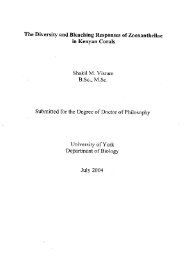
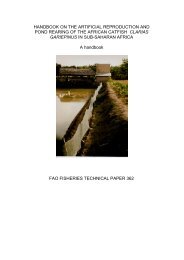
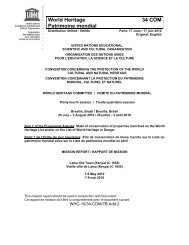
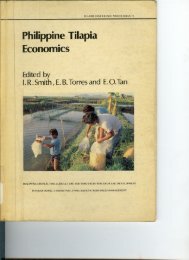
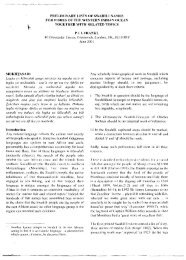

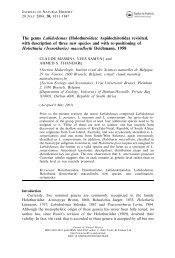
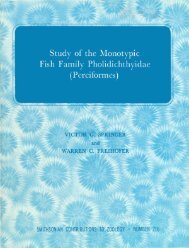

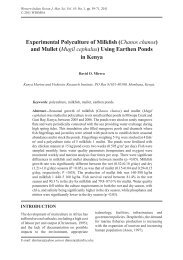
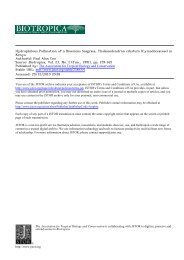
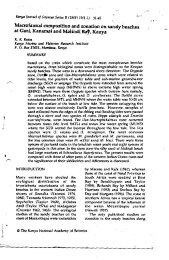
![MSc. Thesis - Lang'at[1].pdf](https://img.yumpu.com/10016993/1/184x260/msc-thesis-langat1pdf.jpg?quality=85)
